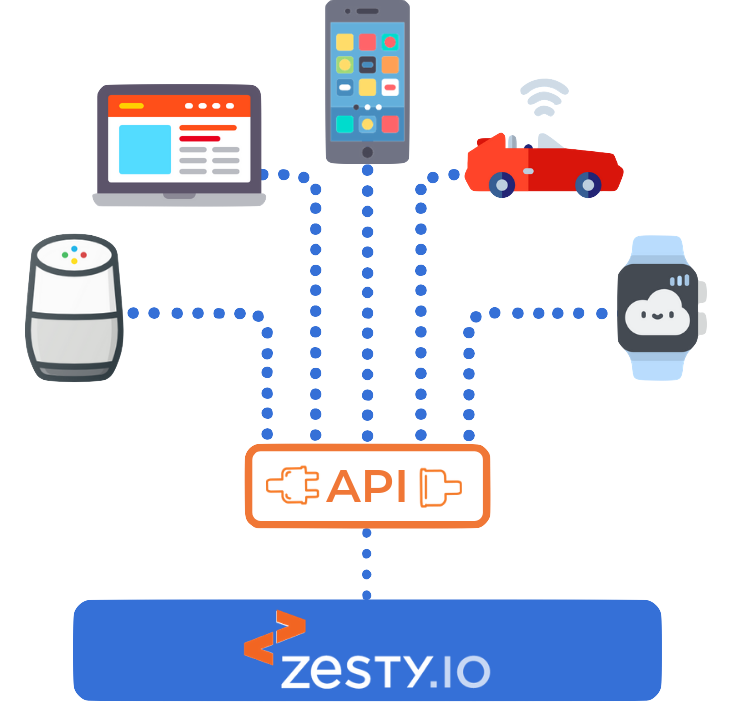In Part 1 of Transitioning from Monolith Software Systems to Modern Website Platforms in 2020, we took a deep dive into the most popular CMS architectures (monolithic, microservices, headless, and decoupled.) Then we played them off against each other in a Royal Rumble to discover the best fit for your organization. In Part 2, we explain on-premise, cloud, and SaaS CMS platforms, find out how they work, and crucially, identify the right time to adopt a new platform, if at all.
The Three (Main) Types of CMS Platform
1. On Premise CMS
As the name suggests, an on-premise (on-prem) CMS is hosted on your internal network, and you alone are responsible for its maintenance. People used to think this meant better security, but that’s been widely debunked - on-prem servers give you more control, but security breaches are just as likely. The cons are easy to identify: you need an internal IT team to run the thing, and the cost of maintenance and updates can run into the hundreds of thousands of dollars.
2. Cloud (Hosted) CMS
Cloud or hosted CMS is similar to on-prem in that you still have to fork out for licensing fees, updates, and upgrades. Traditionally, these have always been the most significant expenses, so no change there. The main difference is that rather than hosting your CMS onsite, hosting is outsourced to a web hosting provider. Rehosting in this way is more scalable and just one less thing for you to worry about!
3. SaaS CMS
With a SaaS (software-as-a-service) CMS, you pay a monthly fee to a third-party vendor who takes care of everything. There’s nothing to install, update, fix, or maintain. It’s cheaper than an on-prem or cloud CMS because the costs of improvements are shared across a broad customer base. And its roadmap is driven by customer demand pooled from the wisdom of the crowd. Furthermore, competition in the SaaS market means new features come thick and fast, often exceeding expectations.
On the flip side, since SaaS solutions are multi-tenant, you don’t have the total flexibility offered by both on-prem and cloud CMS. However, APIs make up for this shortcoming, letting you use countless third-party integrations.
The Technology Behind Modern Software Platforms
Modern software platforms use cloud technology to disassemble monoliths into a suite of different services, each connected via APIs (application programming interfaces). The term API sounds complicated, but it’s not. Let’s use a smartphone as an example. When you look at your phone, you see the user interface (UI). The UI is the space in which you communicate with your phone, and vice versa. An API is the same, but it’s the space in which two machines communicate, rather than one machine and one human operator.

There are API providers and API consumers. The API provider takes a discrete functionality (service) from your IT infrastructure (like your CMS) and puts it out over the internet, along with a developer portal that contains all the documents and downloads a developer needs to make the CMS work. The API consumer develops a web application and embeds the API within it, thus connecting the CMS to the rest of your services.
With APIs, you can benefit from the best tools that the internet has to offer. Say, for example, you need a mapping service on your website. You have two choices: (1) You can take on the software development task yourself, at a high cost, or (2) you can connect Google Maps to your site via APIs by embedding a single line of code. It’s free and provides a better experience for the end-user than anything your team could be expected to make. I choose (2).
CMS Replatforming - How Do You Know When It’s the Right Time to Make a Change?
Re-platforming is the process of selecting new technology to deliver functionality to your organization. Migrating content to a new website can be a complex, costly, and time-consuming process, but under certain conditions, it’s essential. Unlike refactoring, which merely means restructuring your existing code, CMS or eCommerce replatforming means adopting new software and its associated business logic. So, how do you know when it’s the right time to make the switch?
-
Your monolith software system is prohibitively expensive. Its total cost of ownership (TCO) - the sum of all direct and indirect costs incurred by that software - is no longer returning a sufficient ROI.
-
It requires constant maintenance. Patches, updates, and upgrades are expensive, slow, and lead to outages and bugs. It has grown unstable due to underlying technical issues or heavy customization, and it’s starting to hamper the customer experience.
-
It lacks the agility to respond quickly to changing conditions. The competitive landscape is rapidly evolving. Your software system should be highly adaptable, giving you the freedom to launch new products, experiment with new features, and innovate.
-
It’s struggling under the weight of user demand. Bugs, errors, glitches, and lags indicate you may be asking too much of your software. Traffic spikes affect uptime and speed. Poor user experience is impeding conversion rates, and your team is spending a large chunk of its time fixing things with DIY workarounds.
-
It’s painful to use. Your marketing team complains that your CMS is slow, clunky, and unintuitive. It’s hindering their efficiency and stifling creativity.
-
Nobody is using it anymore. Your software system is no longer where it’s at. It’s approaching platform end-of-life, and security is a worry. All the smart people are working on other platforms, and you’re being left behind.
-
You’re starting a new chapter. A recent merger or acquisition, expanding into new territory, launching a new brand, product, or service - these are all watershed moments that can serve as the impetus for re-platforming.
There are plenty of scenarios, too, under which replatforming would be a terrible idea. You need to understand if it’s your platform or its implementation, that is the real source of your woes. If you’ve invested heavily in your current solution, is it worth forking out another chunk of capital on a new one? Do you have the right change management team to provide the necessary training and support as you transition? There are always risks associated with any software migration - data loss, extended downtime, data corruption, compatibility, and application stability, to name but a few.
The most significant barriers to replatforming, however, are not logical but psychological. They’re built on fear. There’s the sunk cost fallacy - you’ve spent an excessive amount of money on your current monolith software system and can’t bear to see it go down the drain. Then there’s the fear of sticking your head above the parapet. Somebody has to make the call, and it’s a big one. If the transition goes wrong, it could cost you your job. This is an understandable concern but irrational. Because if you stick with a failing monolith system, then failure is the guaranteed outcome.
The Replatforming Checklist - 10 Steps to Take Before You Begin
Replatforming shouldn’t be taken lightly. Fail to specify and prioritize your requirements clearly, and you could end up with a solution that insufficiently caters to your needs. Fortunately, there are several steps you can take to ensure a smooth transition to a new CMS and a new architecture. I outline this CMS migration checklist below:
-
Get buy-in as early as possible: All stakeholders have to be fully invested in the replatforming process. This means surveying their needs to find out what can be automated or improved to save time and resources. Regular meetings with senior executives promote transparency.
-
Inventory your team’s skills: Technology is not a panacea. People and processes must be equally integrated into the solution. Does your organization have the skills needed to make replatforming work?
-
Identify the best time to replatform: If there’s a time of year when sales are slowest, this is when you should bite the bullet. Having a solid date in the calendar keeps everyone motivated and on task.
-
Account for all costs: Include initial development, migration, maintenance, downtime, and training. Use TCO and ROI to justify replatforming.
-
Determine successful outcomes: Define goals, objectives, KPIs, milestones, and timelines.
-
Conduct extensive market research: Cast a wide net when surveying the market for your ideal solution. Choose the platform most closely aligned with your business ambitions, not the other way around.
-
Review security regulations: Make sure your new platform exceeds the required standards.
-
Research SEO best practices: Take steps to mitigate any drop in Google rank resulting from the move.
-
Map your existing data: Identify and cleanse all data that will be migrated to your new platform.
-
Survey your integrations: Check if your existing integrations will work with your new platform. And investigate whether built-in functionality will be superior to third-party apps that you’re currently using.




